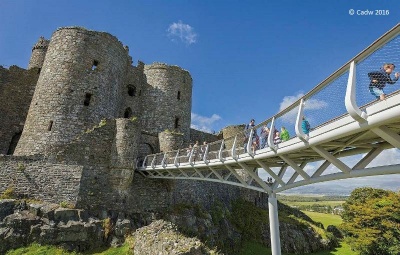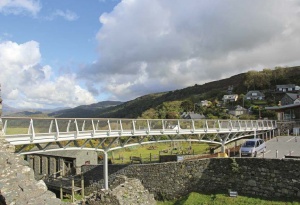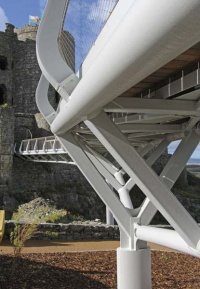Harlech Castle Footbridge
Structural Steel Design Awards 2016 - Award
Harlech Castle is one of the finest surviving 13th Century castles in Britain - it is a Grade I Listed Building, a Scheduled Ancient Monument and also part of a World Heritage Site. For many years access to the Castle had been via a series of timber steps, with no provision for those with impaired mobility. With the opening of a new visitor centre nearby, the vision was to connect this to the Castle via a new ‘floating’ bridge.
Due to the sensitive nature of the site, the aesthetics have been a particularly important consideration. Various concepts were explored to satisfy the constraints of functionality, alignment, heritage and visual impacts before finally opting for the ‘S’ shaped low profile Vierendeel truss design.
Both horizontal and vertical alignments were constrained by the need to connect straight through the Castle’s gatehouse, whilst maintaining a suitable gradient acceptable to those with impaired mobility.
To minimise the impact of the views of the distant mountains of Snowdonia, the profile of the bridge was reduced by tapering the bottom chords of the trusses and eliminating any diagonal bracing, thus avoiding a potentially more cluttered appearance. The visual lightness of the bridge is significantly improved by the selection of a stainless steel mesh infill to the parapets. The deck is 2m wide in general, however it widens up to 3m above the middle support to provide an area where people can enjoy the views.
To ensure that the bridge was ‘future proof’ provision was made for services to be run in a duct under the bridge deck, allowing the creation of a new venue within the castle where events and performances can be hosted.
Throughout the design process there was continuous dialogue between the project team using 3D BIM CAD modelling to explain design proposals and ensure the design developments were acceptable. The first key area for development was the truss and deck configuration. The original proposal had fin plates welded to the back of the CHS Vierendeel truss bracing elements, which then became the tee web in the handrail upright. This arrangement posed some fabrication challenges and raised the possibility of weld distortion in the fin plate attached to the CHS. An alternative solution was adopted whereby SHS bracing was used and the handrail fabricated tee upright orientation was reversed. The face of the SHS Vierendeel bracing then aligned with the flange of the tee to the balustrade which was tapered to give an elegant transition to the handrail, whilst the bracing also gives improved structural capacity particularly at the joint with the CHS chords for a given section width.
To maximise headroom clearances under the bridge, and to give a more efficient structural solution at the supporting columns, the depth of the truss profile was modified and the bottom chord form was achieved from a combination of curved and straight sections of tube.
Design to Eurocodes meant that the bridge’s dynamic performance required careful consideration. The columns needed to be very stiff in the transverse direction so an elliptical section was used which, when partly filled with concrete, achieved the required result. This choice also had the added architectural benefit of the elliptical column being less obtrusive on elevation, whilst approximately matching profile of the truss chord.
Before work started on site the existing façade was digitally scanned and the 3D survey was incorporated into the design model to ensure the critical dimensional interface between the Castle entrance and the bridge was achieved.
Bridge sections were set up in bespoke jigs to control weld distortion and maintain their geometry during welding.
The bridge is lit with a bespoke integrated LED lighting system that delivers bright white task lighting to the walkway, but has the added benefit of having a number of colour-changing effects that can be accessed for special events.
The bridge is finished with a timber deck and handrail for which FSC certified Ekki hardwood was selected, this requires no preservative treatment and little maintenance. The deck boards feature anti-slip inserts and seamlessly follow the curves of the bridge.
The biggest challenge to the installation team was the limited footprint of the site and the restricted access through Harlech. These challenges were overcome with the careful selection of the multi-wheel steer mobile crane and rear wheel steer transport trailers.
Steel erection required meticulous planning and attention to detail to ensure a smooth and safe installation process, however the unique historic nature of the site put even more responsibility onto the erection team. Following offsite matching of the deck units the fit-up on site was perfect and the three main spans were installed without any significant problems. With the bridge sections in place, the careful co-ordination of the fitting of the timber deck, parapets, lighting and services allowed the bridge to be completed in good time ready for its opening for the year’s summer visitors.
The new footbridge has been very well received and welcomed as an attractive addition to the historic site whilst dramatically enhancing the visitors’ experience.
| Concept Designer | Mott MacDonald |
| Structural Engineer | David Dexter Associates |
| Steelwork Contractor | S H Structures Ltd. |
| Main Contractor | RL Davies & Son Ltd. |
| Client | Cadw |
Judges' comment
In a very sensitive setting this elegant bridge provides level access to the historic castle, whilst minimising its visual impact. The detailing and fabrication of the curved deck are exemplary. The erection was effected with a high degree of precision despite the limited site and extremely difficult access.
The modern shapes of the bridge create a beautiful counterpoint to the ancient castle it serves.






